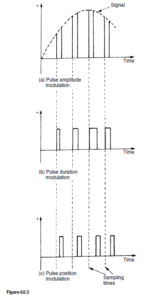Introduction to Modulation
The transmission of information such as speech, music and data over long distances requires the use of a carrier channel. It is common practise to ‘carry’ different communications, called signals, at different frequencies to stop one signal from interfering with another. A signal can be shifted bodily from its original band to another, this being achieved by ‘modulating’ one waveform with another.
The mean frequency level to which a signal is moved is called the carrier frequency and the process of superimposing the information signal on the carrier is called modulation. The resultant signal is called the modulated signal. Many signals, such as telephone conversations, can be transmitted simultaneously along a single pair of lines by using modulation techniques. Modulation of a band of low frequencies on to a higher frequency carrier is fundamental to radio communications, and using different carrier frequencies leads to numerous programmes being transmitted simultaneously. The carrier frequency is the frequency to which the receiver has to be tuned, for example, 97.6 to 99.8 MHz for BBC Radio 1, the signal which is heard being obtained from the modulated carrier by a process called demodulation.
Amplitude Modulation
The carrier frequency must have one or more of its characteristics (i.e. amplitude, frequency and/or phase) varied by the information signal. When the amplitude of the carrier is changed by the information signal, the process is called amplitude modulation. To illustrate amplitude modulation, consider the signal to be a sine wave of frequency fm , as shown in Figure 82.1(a), and the carrier to be a sine wave of frequency fc , as shown in Figure 82.1(b). The result of amplitude modulation is shown in Figure 82.1(c), the signal information being duplicated on both sides of the carrier, as shown by the broken lines, which are construction lines outlining the pattern of change of amplitude of the modulated waveform. This results in a band of frequencies over a range (fc – fm ) to (fc + fm ), i.e. the carrier frequency š the signal frequency band. The frequency range between the highest and lowest of these frequencies is called the bandwidth.
Frequency Modulation
Instead of varying the amplitude of the carrier waveform, the modulating signal may be used to vary the frequency of the carrier. An increase in signal
amplitude then causes a change in the modulated signal frequency, which is proportional to the amplitude of the modulating signal. This is called frequency modulation and is shown for a cosine wave signal in Figure 82.2.
When the signal amplitude is positive, the frequency of the carrier is modulated to be less than it was originally, shown as (a). The original carrier is shown for reference. The modulated wave is in the same position as the
original carrier when the signal amplitude is zero, as shown at (b). When the signal amplitude is negative, the frequency of the carrier is modulated to be greater than that of the original carrier, as shown at (c).
Frequency Deviation, Frequency Swing and Modulating Index
Frequency deviation is a term used in frequency modulation and is defined as the peak difference between the instantaneous frequency of the modulated wave and the carrier frequency during one cycle of modulation.
Frequency swing is the difference between the maximum and minimum values of the instantaneous frequency of a frequency-modulated wave.
The modulating index for a sinusoidal modulating waveform is the ratio of frequency deviation to the frequency of the modulating wave. Thus the modulating index is the ratio of the frequency deviation caused by a particular signal to the frequency of that signal.
Phase Modulation
The modulating signal can be used to advance or retard the phase of the carrier in proportion to the amplitude of the modulating signal. This technique is called phase modulation and this also involves a variation of frequency. In this case it depends on the rate of change of phase and thus on both the
amplitude and frequency of the modulating signal. The waveform is similar to that shown in Figure 82.2.
Pulse Modulation
In pulse modulation, the signal is sampled at a frequency that is at least twice that of the highest frequency present in the signal. Thus for speech, which has frequencies ranging from about 300 Hz to 3.4 kHz, a typical sampling frequency is 8 kHz. Various forms of pulse modulation are used and include pulse amplitude modulation, pulse position modulation and pulse duration modulation.
The principle of pulse modulation is shown in Figure 82.3(a), in which the amplitude of the pulse is proportional to the amplitude of the signal. The amplitude of the pulse may change during the ‘on’ period or alternatively it may be kept constant, resulting in the stepped waveform as shown in Figure 82.3(a).
Figure 82.3(b) shows the principle of pulse duration modulation, the duration of the pulse being proportional to the amplitude of the signal.
The position of the pulse relative to some datum (such as the sampling time), is made proportional to the amplitude of the signal in pulse position modulation, as shown in Figure 82.3(c).
Pulse Code Modulation
In pulse code modulation, the signal amplitude is divided into a number of equal increments, each increment being designated by a number. For example, an amplitude divided into eight increments can have the instantaneous value of the amplitude transmitted by using the natural binary numbering system with three bits, the level being transmitted as: 000, 001, 011,.. ., 111. This concept is shown in Figure 82.4.
Thus in pulse code modulation, an analogue signal is converted into a digital signal. Since the analogue signal can have any value between certain limits, but the resulting digital signal has only discrete values, some distortion of the signal results. The greater the number of increments, the more closely the digital signal resembles the analogue signal.





